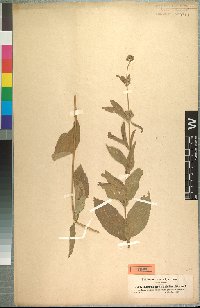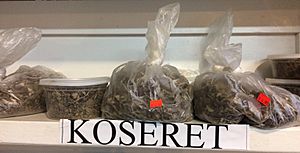Koseret facts for kids
Quick facts for kids Koseret |
|
|---|---|
 |
|
| Lippia abyssinica isotype specimen | |
| Scientific classification | |
| Genus: |
Lippia
|
| Species: |
abyssinica
|
| Synonyms | |
|
List
|
|
Lippia abyssinica, also known as koseret, is a type of flowering plant. It belongs to the verbena family, called Verbenaceae. This plant is originally from Ethiopia, meaning it grows there naturally. However, people now grow it in many other tropical African countries. The second part of its scientific name, abyssinica, is a Latin word. It means 'from Ethiopia', which used to be called Abyssinia.
Koseret is a shrubby plant that can grow up to 3 meters (about 10 feet) tall. It usually grows in high places in Ethiopia, between 1,600 and 2,000 meters above sea level. The plant has hairy leaves and small flowers. These flowers are usually purple or pink.
What is Koseret Called?
Koseret has many other common names. These include kosearut, lemon herb, and butter clarifying herb. It is also known as Gambey tea bush or Gambia(n) tea bush. However, these last two names can also refer to a different plant, Lippia multiflora.
In the Amharic language of Ethiopia, it is also called kesse or kessie. In Gurage, it can be koseret (Amharic: ኮሰሬት, romanized: koserēti), kesenet (Amharic: ክስንት, romanized: kisiniti), or quereret. If you speak Tigrinya, you might call it kusay. In the Oromo language, it's known as Kasey, kusaye, or kusaayee.
In French, people call it verveine d’Afrique, which means 'African verbena'. Other French names are Brégué Balenté or Mousso et mâle. German speakers call it Gambia-Teestrauch, meaning 'Gambia tea shrub'. In Sierra Leone, it is called a-kimbo, and in the Congo, it is known as ngadi or dutmutzuri.
How Koseret is Used
Koseret is a very important herb in Ethiopian cuisine. People dry a special type of koseret, L. a. var. koseret, to use in cooking. It has a unique smell that is a bit like camphor and mint. Some people say its flavor is similar to basil. However, it is not closely related to basil. They are only in the same larger group of plants called Lamiales.
Koseret is actually very closely related to Mexican oregano. Both plants belong to the same group, or genus, called Lippia. Koseret is often used to make special spiced oils in Ethiopia. These include niter kibbeh and ye'qimem zeyet. It is also a key ingredient in the spice mix called afrinj. When used in these oils and spice mixes, koseret helps to keep them fresh. It can even prevent spoilage for many years. These flavored oils and spices then add taste to many common Ethiopian dishes, like kitfo.
In the Democratic Republic of the Congo and the Republic of the Congo, people eat koseret as a potherb. This means they cook and eat its leaves like a vegetable. In West Africa, especially in The Gambia, people brew the leaves to make a herbal tea. This tea is sometimes used as a substitute for regular tea.
Koseret in Traditional Medicine
Koseret has also been used for a long time in traditional medicine. People have used it to help with things like coughs and fevers. It has also been used for constipation and skin problems like burns.
Beyond its use in medicine, koseret can also act as an insecticide. This means it can help to kill insects. It also has antimicrobial properties, which means it can fight tiny germs like bacteria and fungi. Studies have shown that it has some promising antibacterial effects, meaning it can fight off certain bacteria. Koseret also has some antioxidant activity. Antioxidants are substances that help protect your body's cells from damage.




